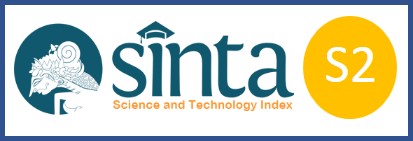Analysis of Total Factor Productivity Growth in The Industry of Textile and Textile Products in Indonesia
Downloads
This study aims to analyze the growth of TFP in the textile industry and textile product (TPT) in Indonesia. Productivity analysis is carried out to determine the extent of performance development and how efficient the textile industry in Indonesia. Calculation of the growth value of Total Factor Productivity (TFP) by decomposing the components of TFP namely TEC, TC, and SEC using the Stochastic Frontier Analysis (SFA). This study uses the type of firm level TPT data in the years 2010-2014. The data used is secondary data which is the result of an annual survey of large and medium manufacturing industry companies conducted by the Central Statistics Agency (BPS) in the form of raw data. The data is in the form of unbalance raw data which is then selected and adjusted to balance data. With 2 industry groups namely the textile industry (ISIC 13) and the garment industry (ISIC 14). Based on the results of the study showed that the average value of TFP growth in 2010-2014 experienced negative growth or <1, this is due to the average growth value of TEC, SEC, and TC which decreased and tended to have negative values in the study period. This shows that the level of efficiency, use of technology, and scale of efficiency of the textile industry tends to be weak in the 2010-2014 period. The reduced level of industrial productivity can affect the decline in the competitiveness of textile products in the global market.
Keywords: Textile Industry and Textile Products (TPT), Total Factor Productivity (TFP), Stochastic Frontier Analysis (SFA)
Jel : L67, C23; O47
Badan Pusat Statistik. (2020). Statistik Industri Besar dan Sedang. .Jakarta : Badan Pusat Statistik
Battese, G. . (1992). Frontier production functions and technical efficiency: a survey of empirical applications in agricultural economics. Agricultural Economics, 7, 185–208.
Beattie, B. R., & Taylor, C. R. (1994). Ekonomi Produksi. Gadjah Mada University Press.
Blanchard, O. (2017). Macroeconomics. Cambridge : Pearson.
Ditjen Pengembangan Ekspor Nasional Kementerian Perdagangan. (2016). Tekstil Dan Produk Kreatif Indonesia.
Fahmy-Abdullah, M., Sieng, L. W., & Isa, H. M. (2018). Technical Efficiency in Malaysian Textile Manufacturing Industry: A Stochastic Frontier Analysis (SFA) Approach. International Journal of Economics and Management, 12(2).
Farrell, M. J. (1957). The Measurement of Productive Efficiency. Journal of the Royal Statistical Society. Journal of the Royal Statistical Society. Series A (General), 120(3), 253–290.
Fazri, M., Siregar, H., & Nuryartono, N. (2017). Efisiensi Teknis, Pertumbuhan Teknologi dan Total Faktor Produktivitas pada Industri Menengah dan Besar di Indonesia. Jurnal Ekonomi Dan Kebijakan Pembangunan, 6(1), 1–20.
Hashim, D. A. (2004). Cost & productivity in Indian textiles: Post MFA implications (Working Paper, No. 147).
Isventina, I., Nuryartono, N., & Hutagaol, M. P. (2015). Analisis Daya Saing Sektor Industri Prioritas Indonesia dalam Menghadapi Pasar ASEAN. Jurnal Ekonomi Dan Kebijakan Pembangunan, 4(1), 71–93.
Jondrow, J., Knox Lovell, C. A., Materov, I. S., & Schmidt, P. (1982). On the estimation of technical inefficiency in the stochastic frontier production function model. Journal of Econometrics, 19(2–3), 233–238. https://doi.org/10.1016/0304-4076(82)90004-5
Jones, C. I. (2014). Macroeconomics Third Edition. W. W. Norton & Company, Inc.
KADIN. (2007). Ringkasan Eksekutif: Visi 2030 & Roadmap 2010 Industri Nasional. KADIN.
Kementerian Perindustrian. (2015). Rencana Strategis Kementerian Perindustrian 2015-2019.
Kneller, R., & Stevens, P. A. (2006). Frontier Technology and Absorptive Capacity: Evidence from OECD Manufacturing Industries. Oxford Bulletin of Economics and Statistics., 68(1), 1–21.
Kurniawaty, H. (n.d.). Total Factor Productivity (TFP) Industri Tekstil dan Produk Tekstil (TPT) di Indonesia Tahun 2005-2009. Jurnal Ilmu Ekonomi Terapan, 42–56.
Lipsey, R. G., & Carlaw, K. I. (2004). Total factor productivity and the measurement of technological change. Canadian Journal of Economics/Revue Canadienne D`Economique, 37(4), 1118–1150.
Pindyck, R. S., & Rubinfeld. (2013). Microeconmics 8th ed. Pearson.
Pitt, M. M., & Lee, L. F. (1981). The measurement and sources of technical inefficiency in the Indonesian weaving industry. Journal of Development Economics, 9(143–64).
Riyardi, A., Setiaji, B., Hasmarini, M. I., Triyono, & Setyowati, E. (2015). Analisis Pertumbuhan Industri Tekstil dan Produk Tekstil di Berbagai Provinsi di Pulau Jawa. University Research Colloquium., 16-25.
Riyardi, Agung, Setiaji, B., Indra Hasmarini, M., Eni Setyowati, dan, & Studi Ekonomi Pembangunan Universitas Muhammadiyah Surakarta, P. (n.d.). ANALISIS PERTUMBUHAN INDUSTRI TEKSTIL DAN PRODUK TEKSTIL DI BERBAGAI PROVINSI DI PULAU JAWA.
Salim, Z. E. (2015). Info Komoditi Pakaian Jadi. http://bppp.kemendag.go.id/media_content/2017/08/IsiBRIK_Pakaian_J%09di.pdf
Sari, D. W. (2019). The potential horizontal and vertical spillovers from foreign direct investment on Indonesian manufacturing industries. Economic Papers: A journal of applied economics and policy, 38(4), 299-310.
Sari, D. W., Khalifah, N. A., & Suyanto, S. (2016). The spillover effects of foreign direct investment on the firms' productivity performances. Journal of Productivity Analysis, 46(2), 199-233.
Satya, V. E., Suhartono, Hermawan, I., & Budiyanti, E., & Sari, R. (2017). Pengembangan Industri Tekstil Nasional: Kebijakan Inovasi & Pengelolaan Menuju Peningkatan Daya Saing. Jakarta: Yayasan Pustaka Obor Indonesia. Yayasan Pustaka Obor Indonesia.
Copyright (c) 2021 Muhamad Nur Wafi, Dyah Wulan Sari, Ph.D

This work is licensed under a Creative Commons Attribution-ShareAlike 4.0 International License.
JIET (Jurnal Ilmu Ekonomi Terapan) (p-ISSN: 2541-1470; e-ISSN: 2528-1879) is licensed under a Creative Commons Attribution-ShareAlike 4.0 International License
Authors who publish with JIET (Jurnal Ilmu Ekonomi Terapan) agree to the following terms:
- The journal allows the author to hold the copyright of the article without restrictions.
- The journal allows the author(s) to retain publishing rights without restrictions
- The legal formal aspect of journal publication accessibility refers to Creative Commons Attribution ShareAlike 4.0 International License (CC BY-SA).












